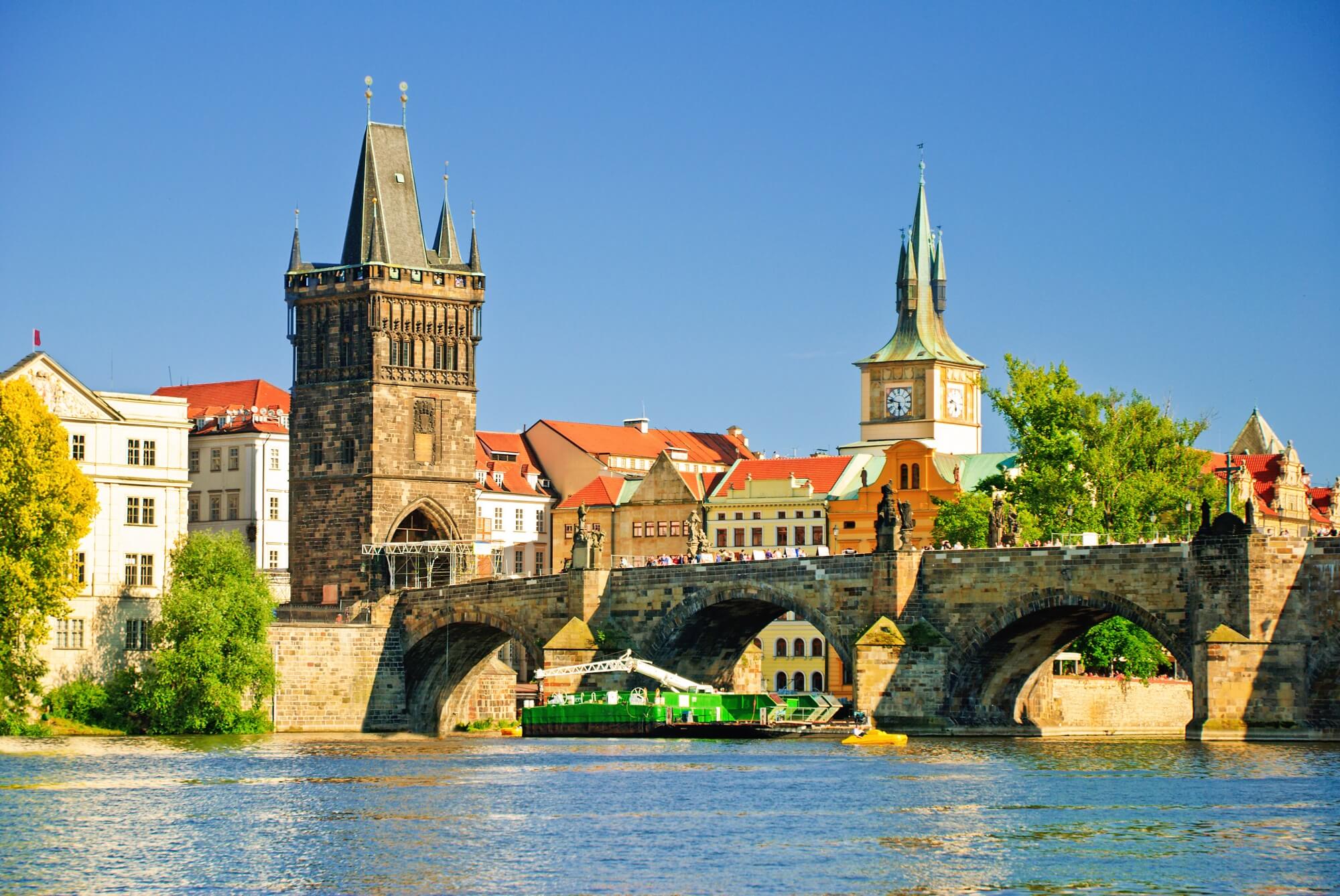ETIAS FOR THE CZECH REPUBLIC
EUROPE’S TRAVEL AUTHORISATION FOR THE CZECH REPUBLIC
This website is not associated with or owned by the EU. The European Union’s official website is europa.eu.
Since the collapse of the Berlin Wall in 1989, the Czech Republic has grown into one of Europe’s most popular tourist destinations.
It is a landlocked country in Central Europe that shares borders with Germany to the west, Slovakia to the east, Poland to the north, and Austria to the south. It has a population of 10.6 million people, with 1.2 million living in the capital city of Prague.
Prague is the Czech Republic’s most popular tourist destination. It is a fascinating, magnificent city known for its mediaeval centre of Gothic architecture. It is nicknamed “the City of a Hundred Spires.”
Despite its small size, the Czech Republic boasts a rich history and a varied people. Czechs, Germans, Jews, and Slovaks have all lived in the area, as did French traders and Italian stonemasons throughout the Middle Ages. Visitors can witness a plethora of castles, monasteries, and other majestic monuments around the country.
Czech Republic
Capital City: Prague
Official language: Czech
Currency: Czech koruna (CZK)
Population: 10.7 million inhabitants
EU member state since: 1st of May, 2004
CZECH REPUBLIC: BASIC INFORMATION
Because of its central European position, the Czech Republic, often known as Czechia, has been dubbed “the heart of Europe.”
Since the collapse of the Berlin Wall in 1989, the Czech Republic has grown into one of Europe’s most popular tourist destinations.
The country is landlocked and shares boundaries with the following ETIAS nations:
- Austria
- Germany
- Poland
- Slovakia
Despite its geographical location, the Czech Republic has an oceanic climate with warm summers and icy winters. However, the weather varies according to height, with colder and rainier temperatures in its mountainous portions and dryer regions surrounding Prague.
The nation has a population of slightly under 11 million people and covers an area of 78,866 square kilometres (30,450 square miles).
Prague, the Czech capital, is the most popular tourist attraction in the country. The city is known as “the City of a Hundred Spires.” It is a fascinating, gorgeous city known for its mediaeval Gothic centre.
Other prominent cities in the Czech Republic worth visiting besides Prague are:
- Brno
- Ostrava
- Pilsen
- Olomouc
- Liberec
Traveling within and between Czech cities is simple because to the country’s well-developed public transportation infrastructure, which includes:
- Metro
- Trams
- City and intercity buses
- Funicular
- Ferries
- Trains
CZECH REPUBLIC AS PART OF THE EUROPEAN UNION
The Czech Republic, like the majority of nations on the continent, is a member of the European Union. It is a member of the European Union, the Eurozone, and the Schengen Area.
The Schengen Agreement allows citizens to freely travel between all participating nations without a visa. Travelers from other Schengen nations do not require a Europe travel visa to visit the Czech Republic.
Visitors from outside the Schengen Area are divided into two categories:
- Citizens from countries eligibles to obtain a Czech Republic ETIAS visa waiver (from November 2023)
- Visitors from non-eligible countries who need a Schengen visa to enter in Europe
Following a referendum in which 77.3% voted in favour, the Czech Republic became an official member of the European Union in 2004. Since its accession, the Czech Republic has collaborated with its European allies to adapt and establish new programmes such as ETIAS Europe, which will become a travel requirement in November 2023.
TRAVELLING TO THE CZECH REPUBLIC
The European Union’s visa waiver agreement with over 50 countries has made it simpler for international travellers to visit the Czech Republic and the other Schengen member countries.
EU passport holders can enter the Czech Republic with only a valid identification document.
Non-EU visitors from visa-free nations can enter Europe with a valid passport; however, ETIAS registration will soon be required.
When the ETIAS for the Czech Republic becomes live in November 2023, travelling to Europe will be safer than ever.
This additional layer of protection will merely necessitate that travellers from qualified countries complete a brief online form. Prior to their journey to the Czech Republic, they will need to register online for an ETIAS visa waiver.
Third-country visitors who do not have a visa waiver arrangement with the Schengen Area will need a Schengen visa to enter the Czech Republic.
IS MEDICAL INSURANCE NECESSARY TO VISIT THE CZECH REPUBLIC?
Certain travellers are obliged to get health insurance before travelling to the Czech Republic, while others are not. The requirement for medical insurance is determined by the citizen’s nationality, which affects whether they are visa-exempt or require a Schengen visa.
Regardless, having health insurance in case of emergency during a vacation to the Czech Republic, or anywhere else in the globe, provides travellers with peace of mind rather than having hospital expenditures quickly build up.
HEALTH INSURANCE FOR SCHENGEN VISA
Travelers must have all of the prerequisites on hand in order to acquire a Schengen visa. One of the required criteria for a Schengen visa is medical insurance.
Furthermore, medical insurance for a Schengen visa to visit the Czech Republic must cover the traveller in the Schengen nations for a minimum of 30,000 euros throughout the whole stay.
Failure to furnish the required insurance coverage while applying for a Schengen visa may result in a visa being denied.
MEDICAL INSURANCE FOR ETIAS CZECH REPUBLIC
Travelers from visa-free countries will be able to register for ETIAS online before to their departure to the Czech Republic beginning in November 2023.
Although ETIAS does not require travellers to purchase health insurance prior to their vacation to the Czech Republic, it is recommended.
CZECH REPUBLIC BORDER CHECKPOINTS
The Czech Republic is a Schengen member nation, thus travellers can travel without crossing borders.
Nonetheless, EU passport holders should have their identity documents with them while crossing the border into the Czech Republic.
Until ETIAS becomes online, non-EU nationals from visa-exempt nations can enter the country with only their valid passport. Travelers from visa-exempt nations will need to have an authorised ETIAS attached with their passport when they arrive at the Czech border from then on.
Third-country nationals from visa-required nations must have a valid passport, a Schengen visa, health insurance, proof of adequate finances to cover their stay, and an onward ticket.
Visitors with more over €10,000 in cash must disclose it at customs.
ARRIVING IN THE CZECH REPUBLIC BY PLANE, TRAIN OR ROAD
The majority of international tourists arrive in the Czech Republic via one of the country’s airports. Prague is home to the primary international Czech airport, Václav Havel Airport Prague (PRG / LKPR).
The Czech Republic also has the following international airports:
- Brno–Tuřany Airport (BRQ / LKTB)
- Ostrava Airport (OSR / LKMT)
- Karlovy Vary Airport (KLV / LKKV)
- Pardubice Airport (PED / LKPD)
The Czech Republic is also extremely well connected by train to numerous major European cities. Among the most popular foreign train connections are:
- Bratislava, Slovakia to Prague (4 hours)
- Vienna, Austria to Prague (4 hours)
- Berlin, Germany to Prague ( 4 and a half hours)
- Budapest, Hungary to Prague (7 hours)
- Warsaw, Poland to Prague (8 hours)
Driving into the Czech Republic is also an option because its motorways are typically well maintained; however, its minor roads may be in rougher shape. To drive on Czech roads, visitors must have a valid driver’s licence and follow local driving restrictions. Driving on major highways requires the purchase of a sticker.
When entering the Czech Republic from another Schengen member state, there are normally no border checks. However, depending on the traveler’s nationality, a valid identity card, passport, and approved ETIAS or Schengen visa are required.

VISITING THE CZECH REPUBLIC
Castles, monasteries, and historic villages dot the hilly terrain of the Czech Republic. Every year, more tourists visit the nation, however the vast majority only see Prague.
Prague is the epicentre of Czech culture and one of Europe’s most visited cities. The mediaeval centre of Gothic architecture is remarkably well-preserved and is the major appeal of the city.
The magnificent Charles Bridge joins two historic districts divided by the Vltava River.
Prague, like Paris and Vienna, is one of Europe’s most attractive cities. The spires of Saint Vitus Cathedral and the Convent of Saint Agnes are two of the highlights.
The art galleries in Prague also have their fair share of treasures. Alfons Mucha has a well-known collection of art nouveau, and Veletrzni has a beautiful collection of 20th-century contemporary painters.
The Czech Republic has a lot of intriguing things to visit for such a tiny country. There are numerous great sites only a short distance from Prague, such as the Karlovy Vary hot springs, the massive Gothic fortress of Karlstejn, and the birthplace of Pilsner: Plzen.
Aside from producing some of Europe’s greatest national beers, the Czech Republic also produces some world-class wines. The Monrovia wine area is the greatest spot to taste Czech wine.
There are various mediaeval towns, spa resorts, and national parks located outside of Prague. The Cesky Krumlov Wild Forests are a UNESCO World Heritage Site that offers an exquisite and unique experience. Olomouc and Brno, both bustling cities, are well worth a visit.
EUROPE’S TRAVEL AUTHORISATION FOR THE CZECH REPUBLIC
To continue increasing security within the Schengen Area, the European Union has been working on the installation of several solutions. The European Information and Authorisation System, or ETIAS, is one of these systems.
ETIAS was certified in 2016 and will be operational in November 2023. It will thereafter become a requirement for all travellers from qualified nations to enter the country.
The European visa waiver may be obtained fully online by completing a short online form, with no need to visit an embassy or consulate.
The ETIAS travel authorization allows holders to enter the Czech Republic, the remainder of the Schengen member countries, and the European microstates.
ETIAS will also be necessary to travel to Bulgaria, Croatia, Cyprus, and Romania, all of which are in the process of becoming members of the Schengen Area.
The vast majority of ETIAS petitions will be accepted within 24 hours. However, it is best to apply at least 2 to 3 business days before the desired date of travel to the Czech Republic to provide enough time for the ETIAS application to be processed.
Once accepted, the visa waiver for Europe will be electronically connected to the applicant’s passport. ETIAS enables repeated Schengen Area entry for up to 90 days within a 180-day period.
The Czech Republic’s European travel authorization is appropriate for business visits, vacations in Europe, and transit in the Schengen Area. It is valid for three years as long as the passport used to apply for it is still valid.
ETIAS REQUIREMENTS FOR THE CZECH REPUBLIC
Applicants must complete the ETIAS application form and fulfil the basic ETIAS conditions in order to acquire a European visa waiver for the Czech Republic.
Applicants will require:
- A machine-readable passport from an eligible country valid for least 3 months after the intended date of departure from the Schengen Area
- An email address the applicant has access to —the approved ETIAS will be sent electronically to this address
- A credit or debit card —to cover the ETIAS fees
On the ETIAS for the Czech Republic application, you must submit your passport information as well as some basic information such as your name, address, and date of birth, as well as answer some easy security and health-related questions.
ETIAS candidates are vetted before the granted authorization is emailed to them. The information submitted in the application is cross-checked against databases such as Europol, Interpol, CIS, VIS, and Eurodac.

